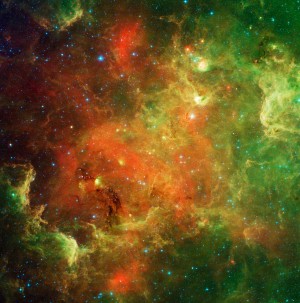Posts Tagged ‘Antares’
EarthSky Tonight—September 13, Waxing moon near

Courtesy of EarthSky A Clear Voice for Science www.EarthSky.org Here is a familiar figure – to stargazers – and to Texans like me. Just yesterday, my little neighbor – age 5 – told me she saw a scorpion. To those of us who watch the skies, the chance to see a celestial Scorpion is present mostly in the summer months. Here it is – Scorpius the Scorpion – only visible at nightfall and very early evening now that summer has faded away. Bright star in east? Might be planet Jupiter, ... Full Story
EarthSky Tonight—August 18, Moon shines above

Courtesy of EarthSky A Clear Voice for Science www.EarthSky.org Every month, the moon swings full circle in front of the constellations of the Zodiac. And each month, as the moon parades past the constellation Scorpius, the moon makes sure to stay a safe distance above the Scorpion’s stinger stars, Shaula and Lesath. After all, the lore of the skies tells us the Scorpion’s stinger put Orion the Mighty Hunter to death. As seen from mid-northern latitudes in North America, the stinger ... Full Story
EarthSky Tonight—August 17, Antares – Fire Star

Courtesy of EarthSky A Clear Voice for Science www.EarthSky.org You have got about another month to see a uniquely summer star, Antares in the constellation Scorpius, in the evening. It is the brightest star near the waxing gibbous moon tonight, in the southern sky as night begins. The moon and Antares will drift westward throughout the night, to set around midnight. Antares sets some 4 minutes earlier with each passing night. By late September, Antares will be tough to spot in the ... Full Story
Earthsky Tonight—August 2, Find a globular cluster

Courtesy of EarthSky A Clear Voice for Science www.EarthSky.org At nightfall, look in your southern sky for the bright ruddy star that is called the Scorpion’s Heart – Antares, the brightest star in the constellation Scorpius. Antares is always up on summer evenings. It is a bright red star known for twinkling rapidly. If you have binoculars, sweep for an object near Antares on the sky’s dome. This object is called M4, and it’s a globular star cluster located just one degree to the ... Full Story
Earthsky Tonight—July 26, The ‘forgotten’

Courtesy of EarthSky A Clear Voice for Science www.EarthSky.org The faint constellation Ophiuchus the Serpent Bearer appears in the southern sky at nightfall, and descends into the southwest sky as evening deepens into late night. Look for Ophiuchus above the bright ruddy star Antares, the brightest in the constellation Scorpius the Scorpion. Ophiuchus’ brightest star – called Rasalhague – highlights the head of Ophiuchus and is nowhere as bright as Antares, the star that depicts the ... Full Story
Earthsky Tonight—July 20, Moon and Antares cross the

Courtesy of EarthSky A Clear Voice for Science www.EarthSky.org There’s a bright star to the east (left) of tonight’s waxing gibbous moon. It’s Antares, often called the Heart of the Scorpion in the constellation Scorpius. You can’t miss this star because it’s bright and reddish in color. Because it’s low in the sky as seen from the northern hemisphere, people in this part of the world often notice that Antares twinkles a lot. You’ll find the moon to the west (right) of Antares ... Full Story
Earthsky Tonight—June 29: Find the Libra stars

Courtesy of EarthSky A Clear Voice for Science www.EarthSky.org Before moonlight floods the nighttime at late night tonight, see if you can spot the constellation Libra’s two visible yet modestly bright stars: Zubenelgenubi and Zubeneschamali. If you live at mid-northern latitudes – like in North America, Europe and Asia – you will see these Libra stars rather low in your southern sky at nightfall and early evening. As seen from middle latitudes in the southern hemisphere – like in ... Full Story
EarthSky Tonight-June 26: See Earth’s orbital plane

Courtesy of EarthSky A Clear Voice for Science www.EarthSky.org It is early evening, and our chart covers a much larger section of sky than we usually display. We are showing the sky’s southeast quadrant – from east-southeast (where the moon lies) to south-southwest (where the star Spica resides). As seen from mid-northern latitudes, this evening’s line-up of lights – the moon, the stars Antares, Zubenelgenubi and Spica – arcs rather low across the southern sky. The farther north ... Full Story
EarthSky Tonight-June 23: Waxing gibbous moon passes

Courtesy of EarthSky A Clear Voice for Science www.EarthSky.org Tonight the moon returns to the constellation Scorpius the Scorpion. The brightest star in the immediate vicinity is Antares, whose name means “like Mars,” because of its similar reddish hue. If you remember your Greek mythology, or perhaps episodes of Xena: Warrior Princess, Ares is the god of war, the counterpart to the Roman god Mars. You can perform the color comparison yourself, because the planet Mars lies in the ... Full Story
EarthSky Tonight, June 22: Moon near Crown of the

Courtesy of EarthSky A Clear Voice for Science www.EarthSky.org Tonight’s moon appears near the upper part of the constellation Scorpius. These three stars are sometimes called the Crown of the Scorpion. Scorpius – which now rises in the south-southeastern sky at early evening, is the constellation of the Scorpion. Individually, the Crown stars are Graffias, Dschubba, and Pi Scorpii. It is rare when star patterns on our sky’s dome have anything to do with real associations of stars in ... Full Story








